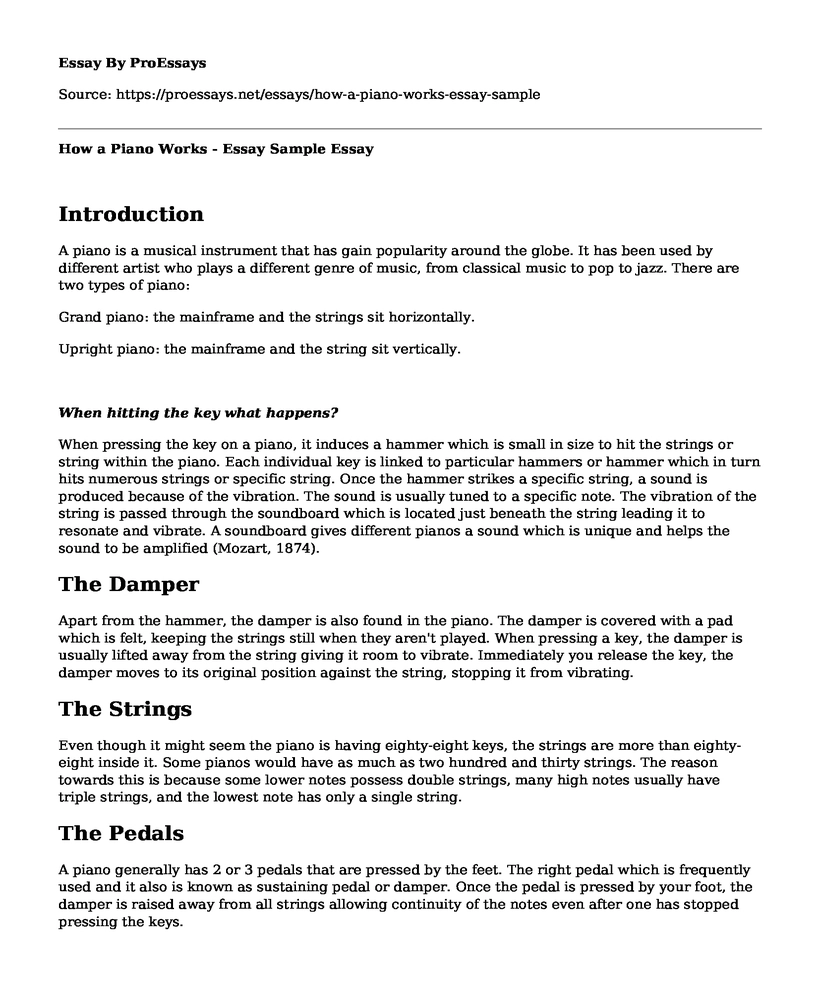Introduction
A piano is a musical instrument that has gain popularity around the globe. It has been used by different artist who plays a different genre of music, from classical music to pop to jazz. There are two types of piano:
Grand piano: the mainframe and the strings sit horizontally.
Upright piano: the mainframe and the string sit vertically.
When hitting the key what happens?
When pressing the key on a piano, it induces a hammer which is small in size to hit the strings or string within the piano. Each individual key is linked to particular hammers or hammer which in turn hits numerous strings or specific string. Once the hammer strikes a specific string, a sound is produced because of the vibration. The sound is usually tuned to a specific note. The vibration of the string is passed through the soundboard which is located just beneath the string leading it to resonate and vibrate. A soundboard gives different pianos a sound which is unique and helps the sound to be amplified (Mozart, 1874).
The Damper
Apart from the hammer, the damper is also found in the piano. The damper is covered with a pad which is felt, keeping the strings still when they aren't played. When pressing a key, the damper is usually lifted away from the string giving it room to vibrate. Immediately you release the key, the damper moves to its original position against the string, stopping it from vibrating.
The Strings
Even though it might seem the piano is having eighty-eight keys, the strings are more than eighty-eight inside it. Some pianos would have as much as two hundred and thirty strings. The reason towards this is because some lower notes possess double strings, many high notes usually have triple strings, and the lowest note has only a single string.
The Pedals
A piano generally has 2 or 3 pedals that are pressed by the feet. The right pedal which is frequently used and it also is known as sustaining pedal or damper. Once the pedal is pressed by your foot, the damper is raised away from all strings allowing continuity of the notes even after one has stopped pressing the keys.
Figure 3: pedal
Pedals of a Piano
At the left, depending on the piano, the two pedals usually have unique functions. On the extreme left, the pedal is commonly known as the soft pedal. The hammers are usually moved to allow the music to play a little bit softer. The hammers may be moved by the pedal a little bit on the side or near to the strings. The pedal at the middle usually raises the damper depending on the particular note being played at that particular time. It may as well raise the damper of the lower notes depending on a specific piano (Smith, 2008).
How a Piano Works
The sounds and notes that are made by the piano are as a result of the vibration from the strings. Once the hammer hits the strings, it vibrates inside the piano. There are eighty-eight keys in a piano which all play a different note. Harmonies and chords are created by hitting the multiple keys at the same time (Zhou, 2017).
References
Mozart, W. A. (1874). The complete Piano works of W. A. Mozart, edited by E. Pauer.
Zhou, Z. (2017). Harmonies and Emotion Expression in Piano Works - Based on Sigh in PianoWorks by Joe Hisaishi. DEStech Transactions on Social Science, Education, and HumanScience, (icsste). doi:10.12783/dtssehs/icsste2017/9394
Smith, J. A. (2008). Music, Women, and Pianos in Antebellum Bethlehem, Pennsylvania: TheMoravian Young Ladies' Seminary. Associated University Presse.
Cite this page
How a Piano Works - Essay Sample. (2022, Dec 05). Retrieved from https://proessays.net/essays/how-a-piano-works-essay-sample
If you are the original author of this essay and no longer wish to have it published on the ProEssays website, please click below to request its removal:
- Intercultural Communication in "The Gods Must be Crazy" Film Essay
- History of Filipino Music Essay Example
- Jazz and Race Revisited Essay
- Mystery & Fiction Writing: Celebrating the Artistic Experiences of Life - Essay Sample
- Women Seeking Fulfilment in Societys Expectations - Essay-Sample
- Three Kingdoms: Resurrection of the Dragon - Uniting China in 14th Century - Essay Sample
- Free Report on Unlocking Success: Google's Online Marketing Triumph for Oct8 Fashion







